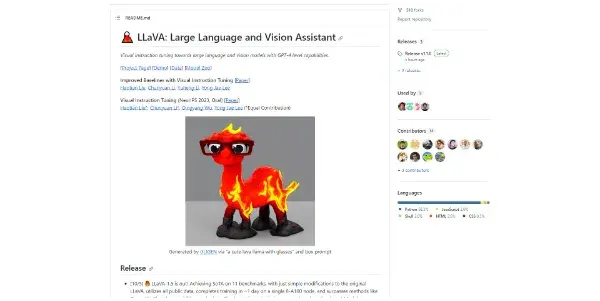LLaVA

A multimodal AI with vision, capable of recognizing an image (like ChatGPT 4). Demo available on GitHub
LLaVA: A Multimodal AI Bridging Vision and Language
LLaVA (Large Language and Vision Assistant) is a groundbreaking multimodal AI model capable of understanding and interacting with both images and text. Unlike purely text-based models, LLaVA possesses the ability to "see" and interpret images, similar to the capabilities demonstrated by OpenAI's ChatGPT 4 with its visual capabilities. This opens up a wide range of applications beyond the limitations of traditional text-only AI. Currently available as a free and open-source project on GitHub, LLaVA represents a significant advancement in multimodal AI accessibility.
What LLaVA Does
LLaVA's core function lies in its ability to process and understand images, then generate relevant and coherent textual responses. This involves several steps: first, the model analyzes the visual content of an image; then, it processes this visual information alongside any provided textual prompts or context; finally, it generates a textual output – be it a caption, description, answer to a question about the image, or even a creative story inspired by the visual input. This seamless integration of visual and linguistic processing sets LLaVA apart from many traditional AI models.
Main Features and Benefits
- Multimodal Understanding: LLaVA's key strength is its ability to understand both visual and textual information simultaneously. This allows for a much richer and more nuanced understanding of the input compared to unimodal models.
- Image Captioning and Description: LLaVA can generate accurate and detailed captions or descriptions of images, automatically tagging objects, scenes, and actions depicted.
- Visual Question Answering (VQA): Users can ask questions about images, and LLaVA will provide text-based answers leveraging its understanding of the visual content.
- Image-Based Story Generation: Given an image, LLaVA can generate creative stories or narratives based on the visual elements and inferred context.
- Open-Source and Accessible: The availability of LLaVA on GitHub allows researchers and developers to access, study, and further improve the model, fostering innovation and collaboration within the AI community.
- Free to Use: LLaVA is currently offered free of charge, removing financial barriers to access and experimentation.
Use Cases and Applications
LLaVA's multimodal capabilities open doors to a wide array of practical applications across diverse fields:
- Accessibility: Generating descriptions for visually impaired individuals from images.
- Education: Creating interactive learning tools that combine visual aids with explanatory text.
- Customer Service: Analyzing customer-submitted images to quickly resolve issues related to products or services.
- Medical Diagnosis: Assisting medical professionals by analyzing medical images and providing preliminary insights.
- Content Creation: Generating creative text content inspired by images, assisting in tasks like writing blog posts or social media captions.
- Robotics and Automation: Enabling robots to understand their visual environment and interact more effectively with humans.
Comparison to Similar Tools
LLaVA stands out from purely text-based language models like GPT-3 or smaller multimodal models due to its advanced capabilities in visual understanding and its open-source nature. While other multimodal models exist, many are proprietary and lack the accessibility of LLaVA. The open-source aspect allows for community contribution and improvement, potentially leading to faster development and broader adoption. A direct comparison with models like ChatGPT-4's visual capabilities requires benchmark testing against the specific tasks, which is an area of ongoing research.
Pricing Information
LLaVA is currently free to use. The project is open-source and hosted on GitHub, allowing anyone to access and utilize the model without incurring any costs. However, it's important to note that usage may require computational resources, and costs associated with running the model on your own infrastructure would be the user's responsibility.
Conclusion
LLaVA represents a significant advancement in accessible and powerful multimodal AI. Its open-source nature, combined with its impressive capabilities in visual understanding and text generation, positions it as a valuable tool for researchers, developers, and anyone seeking to leverage the power of AI in diverse applications. As the model continues to evolve and improve, its impact across various industries is poised to grow considerably.